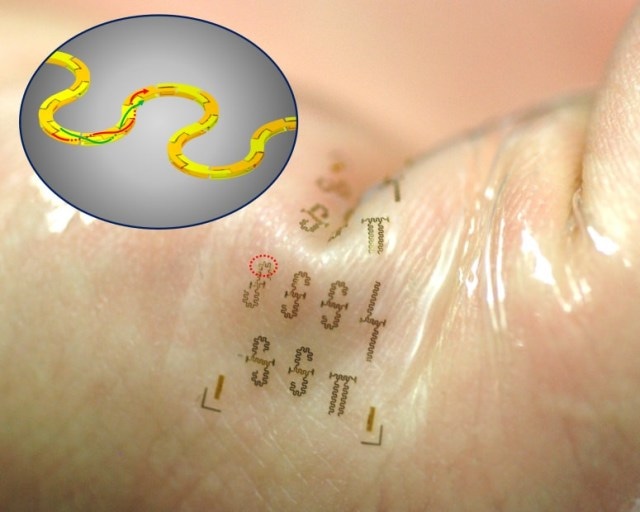May 31 2016
A range of smart, wearable, wireless electronics, which have varied applications right from fitness monitoring or sun exposure to charging other electronics, playing music or purifying air, have occupied a large portion of the consumer marketplace.
 Fabricated in interlocking segments like a 3-D puzzle, the new integrated circuits could be used in wearable electronics that adhere to the skin like temporary tattoos. Because the circuits increase wireless speed, these systems could allow health care staff to monitor patients remotely, without the use of cables and cords. (Image Courtesy- Yei Hwan Jung and Juhwan Lee)
Fabricated in interlocking segments like a 3-D puzzle, the new integrated circuits could be used in wearable electronics that adhere to the skin like temporary tattoos. Because the circuits increase wireless speed, these systems could allow health care staff to monitor patients remotely, without the use of cables and cords. (Image Courtesy- Yei Hwan Jung and Juhwan Lee)
Recently, a group of researchers from University of Wisconsin and Madison engineers have developed the fastest, wearable, stretchable integrated circuits, an invention which can drive the Internet of Things and give rise to a more interconnected, high speed, wireless world.
Under the leadership of Zhenqiang “Jack” Ma, the Lynn H. Matthias Professor in Engineering and Vilas Distinguished Achievement Professor in electrical and computer engineering at UW–Madison, the scientists reported the features of these highly competent and powerful integrated circuits in the Advanced Functional Materials journal, May 27, 2016 issue.
This development is a stepping stone for manufacturers who are looking to extend the abilities and applications of wearable electronics, especially those with biomedical applications. Manufacturers attempt to create devices that utilize the latest generation of wireless broadband technologies known as 5G.
In the wavelength range of millimeter to meter, electromagnetic waves that utilize frequencies in the 0.3 to 300 GHz range are called microwave radio frequencies. These microwave radio frequencies fall in the 5G range.
This would be a boon for mobile communications as the microwave radio frequencies of 5G networks can accommodate the expanding number of cell phone users and also significantly increase the coverage area and data speed.
Epidermal electronic systems are electronic devices that remain attached on the skin similar to temporary tattoos. These devices would be very useful for ICU patients and would assist health care staffs in hospitals to monitor the patients from remote places wirelessly, which would in turn increase the patient’s comfort as the number of entangled wires and cables would decrease.
The unique structure of these new integrated circuits similar to twisted-pair telephone cables makes them more powerful. They usually consist of two extremely tiny intertwining power transmission lines arranged in repeating S-curves.
The ability of the transmission lines to stretch without hindering its performance is attributed to its serpentine shape which is formed with segmented metal blocks in two layers similar to a 3D puzzle. This also helps to protect the lines from external interference and restricts the electromagnetic waves flowing past, totally eliminating current loss. At present, the integrated circuits can function in the radio frequency levels up to 40 GHz.
These recently developed integrated circuits are only 25 µm thick, whereas other stretchable transmission lines are around 640 µm thick. Hence, these integrated circuits would be highly efficient in many applications, like epidermal electronic systems.
For the last decade Ma’s team have been creating transistor active devices, which go hand- in-hand with the expertise of the scientists in flexible as well as high-frequency electronics.
We’ve found a way to integrate high-frequency active transistors into a useful circuit that can be wireless. This is a platform. This opens the door to lots of new capabilities.
Zhengiang Ma, UW-Madison
Other authors on the paper include Yei Hwan Jung, Namki Cho, Juhwan Lee, Sang June Cho, Subin Lee, Huilong Zhang, Tong June Kim and Shaoqin Gong from UW–Madison and Yijie Qiu from the University of Electronic Science and Technology of China.